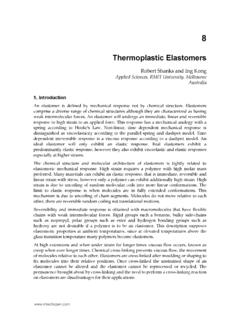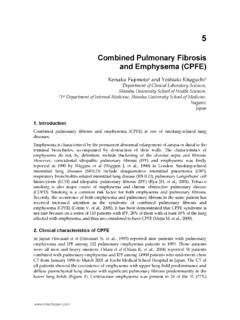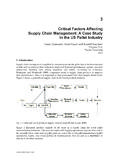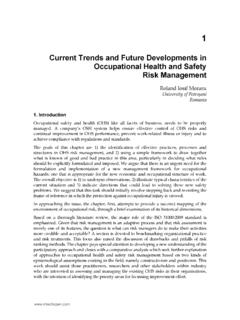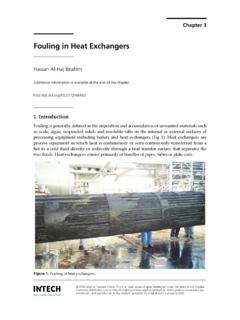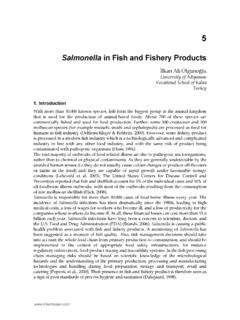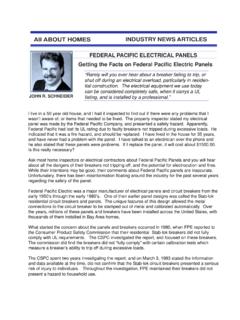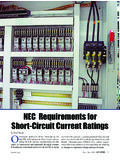Transcription of Architectural Design Criteria for Spacecraft Solar Arrays
1 8. Architectural Design Criteria for Spacecraft Solar Arrays Antonio De Luca VEGA Space GmbH. Germany 1. Introduction Scope of this chapter is to provide Design Criteria for Spacecraft Solar Arrays at system level. The Design a satellite Solar array is usually influenced by several constraints; mission profile, chosen attitude, overall Spacecraft configuration, mass and sizing requirements, etc. Moreover, its Design has to be harmonised with the chosen Solar array power conditioning, in order to optimize mass, dimensions, and also particular constraints coming from EMC. and thermal environments. The chapter is basically composed of the following sections;. 1. General description of the current Solar cell technologies currently used in space, with particular attention to the triple junction Solar cells.
2 2. Mathematical model of an equivalent Solar cell circuit, to be used for performance calculations in a numerical simulation environment. 3. Mathematical description of a simplified thermal model of a Solar array in order to analyse Solar array performances in orbit. 4. Short definition of cosmic radiation effects. 5. The satellite power budget, starting point for the Solar array sizing 6. The impact of the power conditioning architecture on the Solar array (electrical operative point, EMC considerations). 7. The configuration of the Solar array with respect to the Spacecraft . 8. Some Design examples for different missions and satellite configurations. 9. Numerical simulations of Solar array performances as function of the mission profile (orbit propagation, slew manoeuvres, attitudes of particular interest).
3 2. Solar cells for space applications Since the beginning of the astronautic era, photovoltaic devices have been considered for the generation of electrical power on board spacecrafts because of their high power output per unit mass, associated with the fundamental advantage of not having moving parts, present, instead, in all the most used electrical power generators for both terrestrial and aeronautical applications (turbines, motors, alternators, etc.). Therefore the PV array is static, does not produce vibrations or noise, and does not need an active cooling. The Russians were the first, in 1958, to launch a satellite powered with silicon Solar cells. 162 Solar Cells Thin-Film Technologies Solar cells for space applications have to be highly efficient, capable to stand thousands of thermal cycles in orbit where the temperature, according to the mission profile may vary from -150 C to more than 120 C.
4 They have to show a limited degradation during time due to cosmic radiations and Ultraviolet, and they have to resist to the mechanical solicitations mainly linear accelerations and vibrations during launch and orbital manoeuvres, because of these constraints the cells for space are smaller than those for terrestrial applications. In order to have the highest conversion efficiency, Solar cells for space application are developed from mono-crystalline materials. In the past silicon was the most used and the reachable bulk efficiency was not higher than 14%. The advent of GaAs based Solar cells in the last decade of the 20th century took the efficiency up to 19%, and nowadays triple junction Solar cells show more than 30%. Figure 1 shows a very simplified structure of triple junction cell.
5 Front metal p n GaInP. Tunnel p n GaAs junctions p n Ge Metal Fig. 1. Triple junction Solar cell structure While figure 2 reports the quantum efficiency for each junction, it can be clearly seen that the increased efficiency is due to wider wavelength coverage of the absorbed radiation. Fig. 2. Equivalent quantum efficiency as function of wavelength Triple junction GaAs Solar cells are populating more and more Solar generators worldwide, while manufacturers are actively working on four to six junction cells as a way forward always increasing conversion efficiency. Consequently, there is a need to improve the understanding of the electrical dynamic behaviour of multi-junction based Solar array considering that the proper Design of Solar array regulators requires, among others, a good mastering of the Solar section/regulator interface.
6 In order to better understand EMC. aspects connected to the chosen regulation philosophy, which will be discussed further, it is worth to have a quick look at the equivalent capacitance present at the output of a triple junction cell. The figure 3 reports the capacitance measured across strings composed of 15. cells. The cells used are produced by AZUR SPACE Solar Power GmbH. It can be observed that at high voltages the capacitance is considerably increased. Such behaviour has to be Architectural Design Criteria for Spacecraft Solar Arrays 163. taken into account when the power conditioning architecture is chosen, and the relevant devices designed. Gaget2 3G28. 500. 450. 400. Capacitance (nF). 350. 300. 250. 200. 150. 100. 50. 0. 0 10 20 30 40 50. String voltage (V). Fig.
7 3. Capacitance identified for the 15 cells string, Gaget2 and 3G28 (AZUR SPACE. products). 3. Solar cell equivalent circuit The mathematical model of a photovoltaic cell has to take into account the following factors capable to influence the Solar cell behaviour. 1. Intensity of the incident light. 2. Operative absolute temperature. 3. Degradation by cosmic radiation. The Solar cell model, derived from the Mottet-Sombrin's one, is basically a current generator driven by the value of the voltage applied at its terminal according to the equivalent circuit reported below. Generally speaking a Solar cell is a particular p-n junction where the diffusion process (diode D1) co-exists with the generation and recombination effect of the charge carrier (diode D2) induced by the presence of crystalline defects.
8 This model was tested using data relevant to the AZUR SPACE 28% Solar cell, as reported in the datasheet provided by the Manufacturer, and available on company web-site. RS iO. VD RP VO. D1 D2. iD iR RO. iL. Fig. 4. Equivalent Circuit of Solar cell The relevant Kirchhoff equations are: q VD q VD VD. io iL iD exp 1 iR exp 1 . k T 2 k T Rp (1a). 164 Solar Cells Thin-Film Technologies Vo VD RS io (1b). Where: K= 10-23 (J/ K) is the Boltzmann constant;. q= 10-19 (C) is the electron charge;. iL, iD e iR are respectively the current due to illumination, and the reverse currents of the diodes D1 e D2; they are function of the temperature. The equations (1) give the output voltage Vo, and current Io as function of the voltage drop Vd over the diodes D1 and D2. The second and third term of (1a) represent the typical voltage-current laws of the diodes, and the currents iD and iR are the reverse currents of the diodes dependent from the physics of the Solar cell.
9 In general, the Solar cell is characterised by the following data provided in the manufacturer's data sheet, the table below gives the values relevant to the one used for testing the model: Isc mA Short circuit current;. Imp mA Maximum power current;. Vmp mV Maximum power voltage;. Voc mV Open circuit voltage;. dIsc/dT mA/ K Short circuit current temperature coefficient dImp/dT mA/ K Max. power current temperature coefficient dVmp/dT mV/ K Max. power voltage temperature coefficient;. dVoc/dT mV/ K Open circuit voltage temperature coefficient. Such data are given in AM0 ( W/m2) conditions at Tref=28 C ( K) reference temperature. Usually the series resistance is around 300m for a triple junction cell, while for the shunt one 500 maybe assumed. Such resistances may be considered in a first approximation as constant in the operating temperature range of the cell.
10 The values of iL, iD and iR at the reference temperature can be calculated with the (1) in the three main point of the V-I curve; short circuit, maximum power and open circuit, by the least square method. The next step is to define how these currents change with temperature. Concerning iD e iR it is possible to write: Eg . iD C D T 5/2 exp . n1 T . (2a). Eg . iR C R exp . n2 k T . (2b). Where CD and CR are constants independent from temperature, and Eg is the Energy of the . prohibited band gap: T2. Eg E g 0 . T e . e (mA/cm2) (3). Architectural Design Criteria for Spacecraft Solar Arrays 165. With Eg0 = eV, e= 10-4 eV/ K, and e=552 K. The current iL due to illumination is given instead by iL T K T T J tot (mA/cm2) (4). Where Jtot is light intensity (W/ m2), (T) is the efficiency of the cell, K(T) is a coefficient to be determined as function of the temperature.


